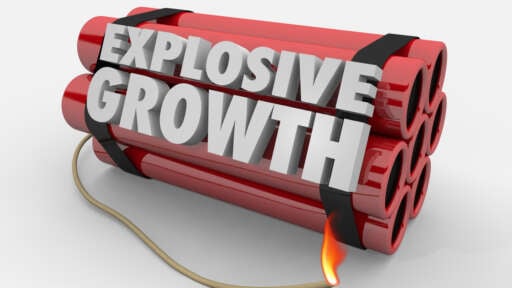
The main reason why active investors don’t make as much money in the stock market as they should is because they sell too early.
Way back in the day, when I was the editor of The Investor’s Chronicle Stockmarket Letter and houses cost less than cars cost now, I noticed a common feature of people who made a fortune in the stock market. They bought shares in a great growth stock and held them forever.
I never met anyone who did the same from active buying and selling.
The single greatest virtue of an investor is patience. Part of the reason why entrepreneurs with publicly quoted companies make so much money is because they don’t sell. They might trim their holdings but substantially they hold their positions for decades and can make vast fortunes as a result.
If you had bought one share in Amazon in first day dealings, when it was already considered to be absurdly overpriced, it would have cost you around $1.50. They are now $3,200. If you had bought 1,000 shares for $1,500 they would be worth $3.2m.
Amazon is special but not unique. Since the mid-1980s, the Nasdaq 100, my favourite benchmark index, has risen from around 100 to over 10,000; that is a rise of over 100 times.
There is an ETF called QQQ, which you can buy to track the performance of this index. There is even another London-quoted ETF called QQQ3 (that’s the code), which delivers three times the performance of the index. Because it is rebalanced daily, unlike the index, its performance can diverge from the index over time but not by that much.
QQQ3 is insanely volatile, it can drop 20pc in a day and 60pc in a month but if you can live with that it can do very well. Since the ETF was launched in 2013 it has risen nearly 28 times.
There is a good case for buying a few and metaphorically sticking them in a safe deposit box. Or you could buy both; that makes sense too because QQQ tracks the index exactly and is far less volatile.
There is also a case for buying a few QQQ3 shares every time it does drop 20pc; that would do very well over time. Unfortunately each share is quite expensive. They are currently $2,509 a share.
Many investors fear that it is too late to buy and that we might be in a bubble. The Nasdaq 100 index is up 60pc since the middle of May. However I have looked back and after previous crashes in 2003 and 2009 the index roughly doubled before having a significant reaction so there is room for it to keep climbing.
There are some other extraordinary things happening too. Interest rates, both short and long, are very low and set to stay that way for some time, maybe years.
Governments are pumping massive amounts of stimulus into the global economy. There are some eye-watering numbers out there. People fear this may lead to inflation but the people saying that have been proved wrong in the past.
Third and by no means last, many of the technology stocks that were doing so well before the pandemic struck have seen their growth accelerate because of the stay-home economy.
This is a potent cocktail to drive shares even higher, which is why I advise readers to hang on in there because this could be a big bull market, which is by no means over.
Indeed, you can plausibly ramp up the excitement even more. I am beginning to suspect that the world is in transition from activities taking place predominantly offline to one where they happen mostly online.
If that is correct; if we are moving from a world of paper, fossil fuel and high streets to something out of Star Trek. There could be a long way to go and technology shares could be just getting started.
This bull market could be an absolute monster. My working assumption is that within my lifetime and I am some way from when that began, the Nasdaq 100 is going to climb from 10,000 to 100,000 and maybe even more.
If this is anywhere near correct that is a massive tailwind for investors and a major reason for hanging on to your winners.
I also think the rest of the world generally and China particularly is gearing up to join the technology party, which is currently so dominated by the US.
I have noticed more and more exciting Chinese based technology shares coming onto my radar in recent weeks. It’s like the beast is stirring.
There has recently been a massive chart breakout for one of the biggest Chinese technology businesses, Alibaba.
Not shown but the equally gigantic Hong Kong-quoted, Tencent, is hitting new peaks and others like Netease (big in video games like Tencent) are also doing well.
China reached 800m Internet users in August 2018 so two years later may be moving towards 1bn users; that is a fantastic market for companies and traditional ways of doing things are being disrupted at an accelerating pace.
Incidentally, the recovery in US stock markets, against a background of continuing bad news on the coronavirus front, seems to have caught many investors, especially institutions with massive funds to invest, flat-footed.
Look at this quote from 22 June 2020:
“The stock market’s rapid rally from its March lows has brought the Nasdaq Composite back to record highs and the S&P 500 nearly positive for the year, but trillions in cash remain parked on the sidelines.
The coronavirus sell-off sent investors fleeing into money market funds, which ballooned well above $4 trillion, surpassing the peak of the 2008-09 financial crisis, according to research by LPL Financial.
The flood into money markets pushed the sector’s assets to the highest on record, peaking at $4.672 trillion during the week of 13 May, according to Refinitiv Lipper, and even recent net outflows have left more than 90pc of that increase intact.”
People keep trying to compare what is happening now with the bubble euphoria of the late 1990s and 2000 but I was there and I can assure readers that conditions then were completely different.
The Internet was an idea, not a reality so many of the overvalued stocks were concept businesses rather like the famous South Sea Bubble company, which raised money without having any business plan beyond the idea of doing something amazing.
The most striking feature of companies raising money now is how fast they are growing. These are real businesses, hitting the ball out of the park already and with spectacular prospects as they address massive markets.
I am looking at companies, loads of them, which leave me breathless with excitement. I know, that‘s easy to do. I keep becoming over-extended in these markets because there are so many ‘must-own’ shares that I want to buy. I feel like a schoolboy in a sweet shop.
What helps me stay bullish is that I don’t pay much attention to the macro-economic environment.
I look at what is happening at companies. I spend my days studying charts, looking at corporate web sites, reading transcripts of quarterly analysts’ meetings and listening to interviews with CEOs.
As a result I see the world through their eyes, through the eyes of men and women, full of optimism, bursting with ambition and plotting and scheming world conquest in the years ahead.
It is a world away from the gloom and doom that seems to be the default position for so many economists and journalists.
These media guys pride themselves on their hard-headed cynicism but so often this makes them put a negative slant even when good things are happening.
I stopped reading their stuff years ago and am much better for that decision.
Even on the Internet, when I read analyses of why optimistic investors have lost the plot and disaster looms I pay no more attention than I did as a teenager in Piccadilly Circus to the biblical looking old buffers with their billboards proclaiming the end of the world is nigh.
When you think about it, really it is obvious that economists, journalists and all the other wiseacres have no more idea what is going to happen to markets than anyone else.
If they did they would change jobs and become yacht-owners or whatever.
The reason why they are so often bearish and I am bullish is partly a personality trait. I am a natural optimist.
I am the mug who believes that trees grow to the sky and you know what, they do!
Microsoft is currently worth $1.6 trillion, that’s $1,600 billion or $1,600,000 million. In 1984, if it had been for sale, you could have bought the whole business for around $700m. At the time net income was around $24m and sales around $100m and everybody, including Bill Gates, thought the shares were crazily over-priced.
Sales this year, to 30 June 2020, are expected to top $140bn, with net income around $44bn and, as we have seen, the market value has increased 2,374 times; that looks to me like a tree that has grown to the sky, past the moon and deep into outer space.
The most wonderful thing about the stock market is that miracles do happen but you have to give them a chance, which is where I came in.
Most investors find it impossibly hard to hang in there. It requires more faith that most of us have. I am not being critical; I find it tough too but increasingly I am trying to behave like a kamikaze pilot in my investing. If I still believe I am going to try very hard to keep the faith.
I have never seen so many wonderful companies in my life, many quoted in the US, where something incredible and historic is happening.
It is possible to create magical portfolios against this background, portfolios of companies that really are changing the world.
Old styles of investing with their preoccupations with dividends, PE ratios, value, never wrong to take a profit and many other ancient shibboleths just don’t cut it any more.
It really is different this time. So much so that I read a quote the other day saying that the most dangerous idea in investment is not the belief that this time it is different but rather the idea that it is always wrong to believe that this time it is different.
It may be hard to make sense of that: the point the guy is making is that if it actually is different and if you have a default position of never believing that you are going to miss out on a massive opportunity.
Personally, I am convinced that it really is different this time and different in a wonderfully exciting way.
One of the weirdest things about this market is that the best shares to buy seem to be the ones that look most expensive.
Many investors are obsessed with value. They want to buy shares that are good value but what is good value. One thing is certain. It is not shares that look cheap. Take Tesco, Barclays, Marks and Spencer and company.
They look cheap but do you want to buy them. It would be like stocking up with flintstones at the beginning of the iron age.
One of the bull points for this market is that there is still a huge iceberg of money stuck in the wrong stocks.
Portfolios built for the 20th century are proving disastrous in the 21st century.
It is an analogy with technology companies built for the era when software was sold for lump sum license payments and pay in advance upgrades.
Companies which had that model, like Microsoft, Adobe, Intuit and many others had to painfully change to the new cloud computing era of software as a service, where customers paid a monthly subscription and expected to always have the latest version.
Many companies have adapted, like the three mentioned above and sales are growing rapidly as a result.
The world of investment may need to do something similar, especially in more traditional areas like insurance funds and pension schemes.
If I see a share like Barclays in a portfolio, especially given my belief that traditional retail banking is heading for extinction, I know I am looking at a portfolio facing backwards not forwards.
The only hope for companies like Barclays, if they find it impossible to adapt, is that they will be bought by some upstart fintech business for their data and their customers.
I have no idea if that makes sense but I find it hard to think of any other reason for buying the shares and the problem for a buyer is that Barclays has over 80,000 employees, which is like a huge poison pill liability.
The Nasdaq 100 is a weighted index. This means that the four technology shares valued at over $1 trillion, Apple, Microsoft, Amazon and Alphabet represent over 40pc of the index by market value.
Can they keep going?



